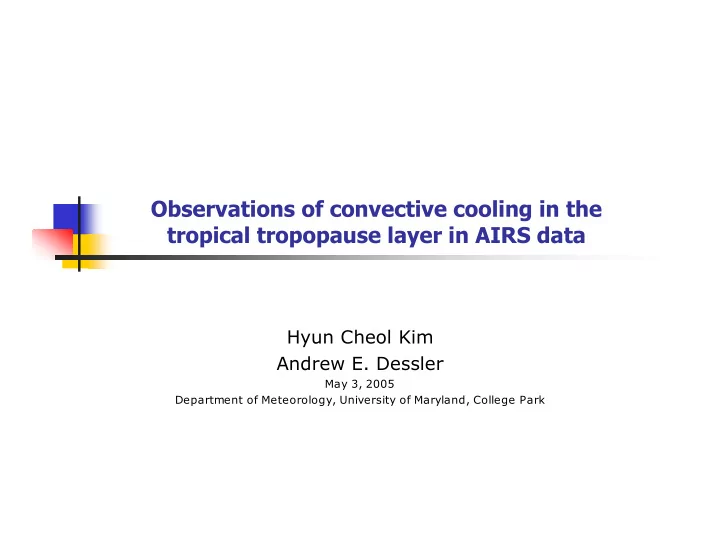

Observations of convective cooling in the tropical tropopause layer in AIRS data Hyun Cheol Kim Andrew E. Dessler May 3, 2005 Department of Meteorology, University of Maryland, College Park
Convective impact in the Tropical Tropopause Layer T = 192K [H 2 O] = 4.52 ppmv Pressure (hPa) TTL T = 165K [H 2 O] = 0.024 ppmv
Tropical tropopause layer Dehydration 16 km Radiative heating TTL Tropopause & Q 0 = 8 km Convection Pole Equator Pole
Data (1) AIRS (Atmospheric Infrared Sounder) - Level 2 temperature profile - Horizontal resolution/coverage : 50 km/Global - Vertical resolution : 28 levels (1100 - 0.1mb) - Temporal resolution : 2/day - Error : < 1 K - Ocean only - Feb. 2003 and Jul. 2003
Data (2) NCEP/AWS Infrared Global Geostationary Composite - Global composite images from four weather satellites in geosynchronous orbit (GMS, GOES-East, GOES-West, Meteosat) - 11 micron Brightness Temperature - Horizontal resolution/coverage : 14 km/Global - Temporal resolution : 48/day - Feb. 2003 and Jul. 2003
Methodology Local monthly mean temperature profiles for 1°x1 ° boxes (AIRS) Individual temperature anomalies (AIRS) T ( lon , lat , t , z ) T ( lon , lat , t , z ) T ( lon , lat , z ) � = � i i mean Assigning convective stage for each temperature anomalies using NCEP/AWS IR image. Averaging temperature anomalies according to their convective stages 1 T ( z ) T ( lon , lat , t , z ) � � � = i n lon , lat , t For convective stages 0,1,…,5
Convective stages C 208 :the fraction of pixels in a box with brightness temperatures below 208K (NCEP/AWS IR image) 10 %
Mean temperature anomaly profile (Feb. 2003)
Cooling rate Cooling rate = -7 K/day
Tropopause cooling Adiabatic lifting - Cold point analysis shows the tropopause moves downward during active convection diabatic component Cloud-top radiative cooling - No diurnal cycle in cooling amount ( Net cloud cooling = in-cloud cooling + solar heating) Turbulent mixing of overshooting air
Radiative cooling? – diurnal separation 100 hPa 1000 hPa Net cloud-top cooling = in-cloud cooling + solar heating
Turbulent mixing of overshooting cloud Overshooting air Mixture Environmental air θ a , m a θ m θ , m m f ( 1 f ) where f a � = � � + � � � = m a m m + a d df � m Q ( ) Cooling rate : = = � � � � a dt dt df Q 7 K / day � (for one convective event) 0 . 35 / day = = = dt 355 K 375 K � � � � a In tropical average: 0.35/day * 3% = 1.05 %/day ~3 months turnover time
Conclusion This study shows a clear signal of cooling near the tropical tropopause during active convection. Estimated cooling rate is –7 K/day. This tropopause cooling during active convection cannot be explained by cloud-top radiative cooling. We suggest that mixing of overshooting air with its environment can possibly contribute to this cooling.
Overshooting convective cloud
The End
Sensitivity test
Adiabatic lifting? Adiabatic P θ + Δθ θ θ - Δθ T
Adiabatic lifting? P θ + Δθ θ Diabatic θ - Δθ T
Cloud-top radiative cooling? (Ackerman et al, 1988) In-cloud heating Solar heating Net cloud-top heating = in-cloud heating + solar heating
Cooling at 100 hPa (Potential temperature anomaly) K
Cloud-top cooing? - T b distribution Cloud fraction to cause –7 k/day 70%
Recommend
More recommend